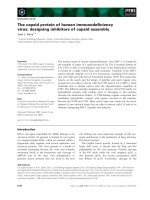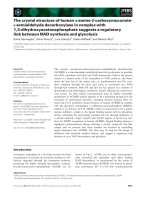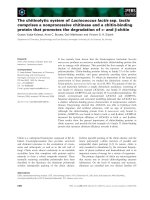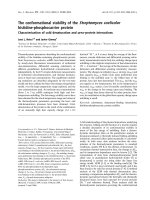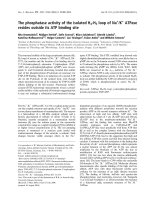Báo cáo khoa học: "The relative importance of cork harvesting and climate for stem radial growth of Quercus suber " doc
Bạn đang xem bản rút gọn của tài liệu. Xem và tải ngay bản đầy đủ của tài liệu tại đây (115.96 KB, 5 trang )
G. Oliveira et al.Stem growth of Quercus suber L.
Original article
The relative importance of cork harvesting
and climate for stem radial growth
of Quercus suber L.
Graça Oliveira
*
, Maria Amélia Martins-Loução and Otília Correia
CEBV – Centro de Ecologia e Biologia Vegetal, Faculdade de Ciências da Universidade de Lisboa,
Campo Grande, C2, 4º, 1749-016 Lisboa, Portugal
(Received 16 May 2001; accepted 9 October 2001)
Abstract – Growth of cork-oak (Quercus suber L.) in Iberian stands may depend not only on climate but also on recurrent cork harves-
ting and stand management. In this work, trees from sites with different managements were studied for 3–6 years. Radial increments
were enhanced following harvesting (4.0–8.2 mm yr
–1
), and decreased afterwards (< 4.3 mm yr
–1
). Time after harvesting was the primary
factor affecting radial growth of Q. suber, but trunk growth also correlated negatively with Autumn-Winter precipitations and minimum
temperatures, and positively with Spring rainfall. Spring radial increment varied significantly between sites.
climate / cork harvesting / montado / Quercus suber / growth
Résumé – Importance relative de la récolte du liège et du climat sur la croissance radiale de Quercus suber L. La croissance du
chêne liège (Quercus suber L.) des peuplements ibériques peut dépendre non seulement du climat mais aussi de la récolte du liège et de
l’aménagement du peuplement. Dans ce travail, des arbres provenant de sites caractérisés par divers types d’aménagement ont été étu
-
diés pendant 3 à 6 ans. L’accroissement radial était accrû après la récolte (4,0–8,2 mm yr
–1
), et diminué ensuite (< 4,3 mm yr
–1
). Le temps
depuis la récolte était le facteur primordial affectant la croissance du tronc de Quercus suber, mais celle-ci était aussi corrélée négative
-
ment avec les précipitations et températures minimales de l’automne et de l’hiver, et positivement avec la pluviométrie printanière. L’ac
-
croissement radial au printemps varie significativement entre les sites.
climat / récolte de liège / montado / Quercus suber / croissance
1. INTRODUCTION
Low-density stands of Quercus suber L. (montados)
are economically important in Portugal because of cork
production, often associated with livestock or cereal
cropping. Climate determines tree growth [4], but in
cork-oak other factors may also be involved: the
periodical cork harvesting, which implies considerable
tissue regeneration [6]; and agrosilvicultural practices,
which change stand characteristics such as tree density
and regeneration, competition between trees, and avail
-
ability of resources. The relative weight of all these
Ann. For. Sci. 59 (2002) 439–443 439
© INRA, EDP Sciences, 2002
DOI: 10.1051/forest:2002018
* Correspondence and reprints
Tel.: (351) 21 7500000; fax: (351) 21 7500048; e-mail:
factors is unknown. Experimental approaches are com
-
plicated by the slow growth of Q. suber, its large hetero
-
geneity (size, form, age) and the recurrent cork
harvesting. Here we present a first study of the effects of
cork harvesting and climate on stem radial growth of ma
-
ture cork-oaks in differently managed montados of SW
Portugal.
2. MATERIALS AND METHODS
Two sites were chosen: a pure stand of Q. suber
(81 trees ha
–1
), at Cruz de João Mendes (CJM – 38
o
05’ N,
8
o
39’ W, elevation 290 m), used for cork production and
occasional sheep grazing; and two neighbouring pure
stands at Herdade do Pinheiro (HP – 38
o
28’ N, 8
o
42’ W,
elevation 27 m), with an improved pasture for livestock
at HPp (“pastured”, 79 trees ha
–1
), and no fertilisation nor
grazing at HPu (“undisturbed”, 88 trees ha
–1
). Meteoro-
logical data (1990–1995) are from the nearest weather
stations (figure 1). Summer rainfalls were negligible
(<8mmyr
–1
).
In Portugal, cork is harvested in early Summer every
nine years. In a given montado, cork-oaks are generally
unevenly aged and developed because they were not de-
liberately planted. As a result, not all the trees have the
same cork thickness, and are not all harvested on the
same year. Considering this, as well as the low density of
stands, the selection of a homogeneous sample of trees
was limited to 7–12 trees at each site (table I). According
to year of the last cork harvesting, the trees were grouped
into “86”, “88”, “90” and “92”.
Radial stem growth was assessed with a depth mi
-
crometer (Series 129-Mitutoyo, MGF Co. Ltd., Tokyo,
Japan), measuring the distance between a frame attached
to the cork and a lag screw embedded in the wood [7].
Data refer to the south side of the trunk at breast height
(1.30 m), and are presented as radial increments (wood
plus cork) over March-late June (Spring) and March-
February (annual). These periods were defined according
to the phenology of this species [7].
Principal component analyses included the whole data
set to identify the general relationships among variables
related to growth, climate, time after cork harvesting, and
management. Values were log transformed to give equal
weighting to each variable. Comparisons between
montados were made with one-way ANOVAs (P < 0.05)
and Tukey HSD tests for unequal sample sizes. All analy-
ses were done with the Statistica package (StatSoft,
1995, Tulsa, USA).
3. RESULTS
Stem radial growth of Q. suber occurred primarily in
Spring at CJM (table II), but at HP a considerable incre-
ment was recorded in Autumn.
440 G. Oliveira et al.
15
16
17
18
19
CJM
HP
1990 1991 1992 1993 1994 19951989
0
100
200
300
400
500
600
700
800
Cumulative rainfall (mm)
Mean
temperature (°C)
Figure 1. Climatic characteristics concerning the years
of study at each site – CJM (1989–95, grey and white
bars) and HP (1992–95, black and stripped bars). Cumu
-
lative precipitation from October (previous year) to
February (darker bars) and March to September (lighter
bars). Average annual air temperatures are displayed for
CJM (circles) and HP (squares).
The principal component analysis revealed a strong
association of climatic variables with the first axis, which
accounted for 37% of data variability (figure 2). Growth
variables were not well represented by this axis but
tended to correlate negatively with Winter precipitation
and with temperature variables, and positively with
Spring rainfall. Radial growth was well and inversely
correlated with time after harvesting; this group of vari
-
ables was well described by axis 2 (27% of total vari
-
ance). Factor 3 explained 13% of total variance, and was
strongly associated with management, though rather
poorly with growth variables.
The growth rate was high during the first two years
(4.0–8.2 mm yr
–1
), as a new cork layer was being formed
(figure 3). Afterwards, radial increments decreased
(< 4.3 mm yr
–1
, trees “88” and “86”). On the first Spring
after harvesting, radial increment was rather small at
CJM (table II) as compared to the following years. In
contrast, at HP radial growth on the first Spring after har
-
vesting roughly halved the annual value, similarly to the
following Spring increments (table II).
4. DISCUSSION
The relative proportion of Spring and Autumn
growths varied among the montados (table II). Intense
Spring growth results in a thicker cork through increased
number of cell layers [6]. It would be interesting to study
whether the similarity between the two increments at HP
derived from comparable numbers of new cell layers, or
from distinct morphological characteristics of the new
cells.
Thickening of cork is enhanced on the first years after
harvesting, and decreases afterwards [6, 8]. Our study
extends this conclusion to the whole radial growth, i.e.
wood plus cork. Some authors found no effect of cork
harvesting on wood growth [1], but cork extraction in
-
duces physiological reactions which may affect tree pro
-
ductivity [3], and this may be expected to affect wood-
ring width.
Precipitation influences radial growth of Quercus ilex
[5, 9] and the growth of cork in Q. suber [2, 6]. Spring
(but not Winter) precipitation seemed to correlate
Stem growth of Quercus suber L. 441
Table I. Characteristics of the selected cork-oaks in each stand. Values at the beginning of the study (1989 at CJM; 1992 at HP).
Stand Last cork harvesting Cork age
(yrs)
Number of trees dbh
#†
(m)
Tree height
#
(m)
CJM 1990
1988
1986
0
§
1
3
2
4
6
0.42 (0.01)
0.42 (0.04)
0.42 (0.09)
7.5 (0.5)
8.0 (0.6)
9.9 (0.9)
HPu 1992
1988
1986
0
4
6
3
4
1
0.57 (0.06)
0.37 (0.06)
0.42
11.3 (0.9)
7.9 (0.7)
6.0
HPp 1992
1988
1986
0
4
6
3
2
2
0.46 (0.01)
0.38 (0.08)
0.34 (0.03)
8.9 (0.1)
8.0 (0.5)
7.2 (1.4)
#
means and standard errors;
†
dbh – trunk diameter at 1.30 m;
§
in 1990.
Table II. Proportion (%) of Spring relative to annual radial increment at the three stands – CJM, HPu and HPp.
Years after cork harvesting CJM HPu HPp
1 25±15(2) 53±14(3) 42±2(2)
2–3 69 ± 3 (12)
a
41 ± 4 (5)
b
51± 3 (6)
b
4–9 66 ± 2 (44)
a
47 ± 4 (14)
b
53 ± 5 (8)
b
Values are averages ± SE, and sample sizes. Different letters on a line represent significant differences (P < 0.05).
positively with stem increment (figure 2). Although Au
-
tumn-Winter and Spring temperatures also influence ra
-
dial growth [5, 9], the results (figure 2) agree only with
the finding that cork growth correlates positively with
Spring temperatures, and is hindered by warm late
Springs and Autumns [2].
No consistent differences in annual growth were
found between different montados (figures 2 and 3).
However, growth was more evenly distributed through
-
out the year at HP, whereas at CJM Spring growth pre
-
vailed (table II), suggesting different seasonalities in
resource availability at the two sites.
The results showed that cork extraction is the primary
determinant of radial increment in Q. suber. However,
great stem growth does not necessarily reflect a good
cork production because of the significant irregularity of
cork quality [8]. The high variability in most growth pa
-
rameters [this study; 7, 8] indicates that each tree is able
to perform quite differently to the availability of re-
sources, and this may be a key feature for the survival and
productivity of Q. suber.
442 G. Oliveira et al.
Factor 2
1
.75
.5
.25
0
25
5
75
-1
Factor 3
Factor 1
1
.75
.5
.25
0
25
5
75
-1
1.75.5.250 25 5 75-1
WP
SP
WmT
SmT
M
H
SG
AG
WP
SP
WmT
SmT
M
H
SG
AG
Annual radial increment (mm)
Time after cork harvesting (yrs)
'86'
'90'
'92'
'88'
CJM
HPu
HPp
2
4
6
8
10
02468
Figure 2. Results from a principal component analysis of the
studied variables: radial increments – Spring growth (SG) and
annual growth (AG); climate – cumulative precipitation of Octo-
ber-February (Autumn-Winter precipitation, WP) and of
March-June (Spring precipitation, SP), and minimum air temper-
atures (Autumn-Winter, WmT and Spring, SmT); years after
cork harvesting (H); and level of stand management, M (0 for
HPu, 1 for CJM, and 2 for HPp). n = 95.
Figure 3. Variation of annual radial increment with time
after cork harvesting. Values are shown for recently har
-
vested trees (white symbols; “90”, at CJM; “92”, at HPu
and HPp), and for trees harvested in 1986 and 1988 (grey
and dark circles, CJM). Each symbol represents the
mean ± SE of 2–3 (“90” and “92”) or 4–6 (“86” and
“88”) trees.
Acknowledgements: We thank the owners of the
montados for permission to work there, A. José for in
-
stalling the measurement devices, A. Caritat for helpful
suggestions, and the financial support of JNICT
(BD/1630–IE) and MOST (EV 5V–CT92–0210).
REFERENCES
[1] Caritat A., Molinas M., Oliva M., El crecimiento radial
del alcornoque en cinco parcelas de alcornocal de Girona, Sci.
ger. 18 (1992) 73–83.
[2] Caritat A., Gutiérrez E., Molinas M., Influence of wea
-
ther on cork-ring width, Tree Physiol. 20 (2000) 893–900.
[3] Correia O., Oliveira G., Martins-Loução M.A., Catarino
F.M., Effects of bark-stripping on the water relations of Q. suber
L., Sci. ger. 18 (1992) 195–204.
[4] Fritts H.C., Tree Rings and Climate, Academic Press,
London, 1976.
[5] Nabais C., Freitas H., Hagemeyer J., Tree-rings to cli
-
mate relationships of Quercus ilex in NE-Portugal, Dendrochro
-
nologia 16–17 (2000) 41–48.
[6] Natividade J.V., Subericultura, DGSFA, Lisboa, 1950.
[7] Oliveira G., Correia O.A., Martins-Loução M.A., Catari
-
no F.M., Phenological and growth patterns of the Mediterranean
oak Quercus suber L., Trees 9 (1994) 41–46.
[8] Ferreira A., Lopes F., Pereira H., Caractérisation de la
croissance et de la qualité du liège dans une région de production,
Ann. For. Sci. 57 (2000) 187–193.
[9] Zhang S.H., Romane F., Variations de la croissance ra
-
diale de Quercus ilex L. en fonction du climat, Ann. Sci. For. 48
(1991) 225–234.
To access this journal online:
www.edpsciences.org
Stem growth of Quercus suber L. 443


